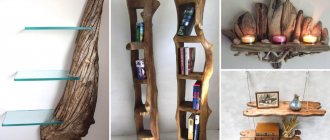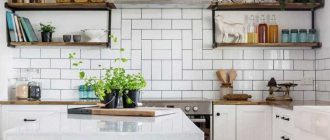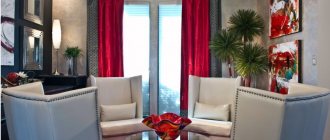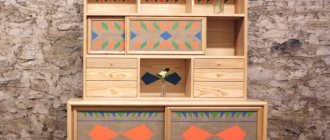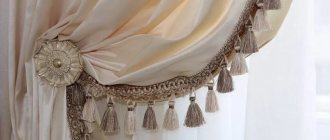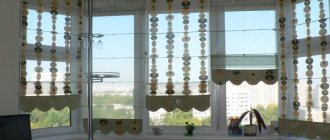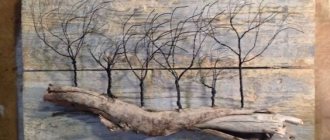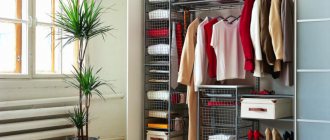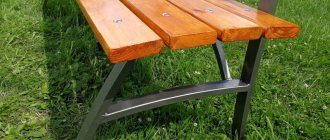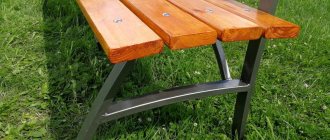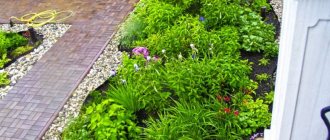The beauty of interiors and adjacent areas is created not only by construction and finishing materials. They will not look so impressive if you do not complement them with decorative elements, contrasting spots and interesting shapes.
These properties are combined in decorative furniture, for the manufacture of which unusual materials are used. Furniture made from driftwood and branches is worth trying your hand at making unusual tables, chairs, armchairs and small decor.
Working with wood in its natural form requires experience and artistic vision.
What is best to use as a raw material and where to look for it?
Not all wood is suitable for furniture. Lucky are those who manage to find oak (especially stained), larch or ash.
When choosing a material, it is important to see in advance what part or furniture it will be used as, since the natural shape of the branches is complex.
Almost finished composition - furniture made from tree roots
Depending on where the branch is found and what condition it is in, the processing will differ.
Fresh ones are dried; those caught from the water are first cleaned of rot and rotten layers.
Irregularly shaped branches are used to create structures that are classic in human understanding.
Processing methods
A stump (stump, log) is a tree. Wood is a natural material and is susceptible to rotting. When it dries, it shrinks; when it gets wet, it swells. They process and protect hemp or logs to create crafts in several ways that can be combined with each other:
- Chainsaw cutting. Shaped cutting with a chainsaw to create crafts from stumps and logs for the garden and home is used to create tables, chairs, stools, and armchairs. Cutting with a gas or electric saw requires certain skills and compliance with safety precautions. You can learn how to operate a chainsaw on our website. Before cutting, it is better to make markings, outlining the contours of the future craft, for which you can use a regular pencil. And then, as with sculptors: we take a log and cut off all that is unnecessary from it.
- Firing with a burner. It will delay the rotting of hemp and give it a beautiful, aged appearance. To do this, after firing, it is necessary to clean the burned surface from excess charred wood using sandpaper, a metal brush or an angle grinder (“grinder”) with a brush or grinding disc.
- Protection. To protect wood before painting, it is necessary to use wood antiseptics, the simplest and most inexpensive of which is iron sulfate.
- Grinding. For grinding, an angle grinder with a brush or grinding disc is most often used. A brush with metal bristles, less often sandpaper. Various grinding machines are also used.
- Painting, varnishing or waxing. It will also delay rotting and give a beautiful appearance, especially when using varnishes and waxes. The varnish must be applied in at least 2 layers, allowing the previous one to dry, or even better, after applying a layer of varnish and drying it, sand the surface before applying the next layer.
What is the value of furniture made from branches, driftwood and stumps?
First of all, of course, uniqueness. No one in the world has the same furniture, since natural exclusivity is used - there are no identical branches, just as there are no identical fingerprints.
Decorative candlestick made of planks
Beneficial features:
- Safety. The material does not cause allergies, it does not contain toxins and other delights that factory products are full of.
- Reliability, especially if roots were used. With high-quality assembly, furniture lasts for decades.
- You can assemble any piece of furniture, since the material used is different (in shape and size).
There are no disadvantages, although insects may live inside the raw material, which must be exterminated, otherwise they will crawl out during the heating season.
DIY furniture made from branches
It is impossible to calculate the shape and type of raw materials in advance, so everything happens right in the master’s head. You need to imagine in advance how the parts will be fastened together, what the result will be.
The best assistant here is experience, which comes only with time. Before working on a large-scale design, it is imperative to practice on simple shapes and designs.
Preparation
If the raw materials have already been found, you need to carefully consider each detail and imagine how it can be used. At this stage, you should have an idea of the layout of the branches.
You can take another path - imagine a certain shape of the product, depict it in the form of a sketch, and only then go in search of a suitable material.
Bench made of driftwood
Next, the material is processed:
- cleaned from dirt and rot;
- remove the bark (not always and everywhere);
- dried under a canopy in natural conditions;
- or dry in an unheated room.
Sanding, impregnation with antiseptics and painting are rather production steps, and are performed either during or after assembly.
How does the assembly work?
Snags and branches are difficult to fit together, as they have an irregular shape.
To make the furniture reliable and durable, you must follow several rules:
- Before starting assembly, after adjusting the parts to size, it is necessary to prepare the ends of the branches and roots. Ideally, they need to be given a concave shape.
- You also need to clean them with a coarse brush, using gentle clockwise movements.
- Then use an electric drill with a medium-hard brush attachment and finally polish the surface with fine-grained sandpaper.
- The parts are connected using the following methods: gluing, according to the tenon-groove principle (the tenons are made wedge-shaped), using self-tapping screws.
For furniture that will bear some kind of load, only rigid fasteners are used.
Hot glue works well for joining parts together.
Finishing
Such furniture can be left unfinished, but most often they try to emphasize the wood grain and make it more contrasting.
For this purpose, different impregnations are used - stains, oils, as well as covering compounds - the same varnishes.
DIY stump furniture
If a smooth surface is needed, cracks and chips are filled with transparent epoxy resin, which creates the effect that the wood is inside the glass.
Epoxy resin connects the saw parts
There are a lot of options for decorating such furniture.
Types of tables
There are several popular types of hemp tables. Here are the main types of structures in terms of material processing features:
- Natural looking product. This is the easiest design to manufacture; it involves the use of a stump in its original form. The only processing that needs to be done is sanding. It is necessary to ensure that table users do not get splinters.
- Painted furniture. If desired, the stump can be painted in any color or patterns can be applied to it using a stencil or brush. Painting the product allows you to adapt it to the interior, made in a certain color scheme.
From the point of view of the design features of the finished product, the following types of tables can be distinguished:
- Furniture with glass. If the master plans to make a coffee or coffee table, then he can use a stump as a stand to which a glass table top is attached. The parts of the structure are connected to each other using screws or special glue.
- Product with legs. The table can be equipped with legs of any length. New wooden or chrome-plated legs, as well as legs from old furniture, are suitable for work. Forged racks of openwork shapes allow you to make the table more elegant and unusual. Legs not only improve the appearance of the furniture, but also reduce the likelihood of scratches on the floor when moving the product from place to place. In addition, the legs raise the stump above the floor and allow air to circulate underneath it. All this allows you to extend the life of the structure.
- Table on wheels. Instead of legs, you can attach wheels to the bottom of the furniture. This will significantly increase the mobility of the structure.
- A product made from bars connected to each other. If the master has several thin wooden blocks instead of one large stump, then they can be connected to each other using glue or fasteners. The result is a table with an unusual shape. It can be equipped with a glass or wooden tabletop.
- A “one on top of the other” type structure. There is an easy way to make an original coffee table. To do this, you need to take several slices of wood of different thicknesses and place them one on top of the other with a slight offset.
- A table made from a cut trunk. If the furniture maker has a whole tree trunk at his disposal, then it can be cut into two halves or carved into a rectangle and used as furniture for the home or garden.
Other design options are possible, it all depends on the imagination of the master.
